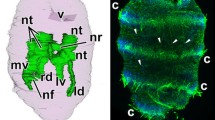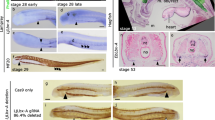Summary
The differentiation of ectodermal cell rows arranged on the germ band ofDiastylis behind the presumptive mandibular segment is described. 4 of the cell rows are not budded off from ectoteloblasts, but are formed directly by blastoderm cells. Behind these 4 rows, 12 cell rows are budded off from ectoteloblasts. Eventually, the ectoteloblasts divide to form rows XIII and XIV. All of these cell rows have a fixed sequence of mitoses by which a detailed analysis of the cell-lineage up to the formation of ganglion anlagen and appendage buds is possible. The rows (0) and (1) form the anterior and middle parts of the maxillular segment. The posterior part of this segment is formed by derivatives of the subsequent cell row (2). Thus, the maxillulae are complex structures, composed by cells from different cell clones. The maxillae and the thoracic limbs are complex structures as well. Rows (2) and (3) have a similar differentiation pattern. The differences are mainly found in the appendage-forming parts. The differentiation of row (3) is nearly identical to row I, i.e. the first row budded off from ectoteloblasts, and to the subsequent rows II–VI.
Ganglion cells are formed by the division of ganglion mother cells that are budded off from neuroblasts. The neuroblasts have a complicated pattern of divisions. There may be an alternation of unequal and equal mitoses. The intersegmental furrows run in a transverse and slightly oblique plane through the derivatives of one cell row. They do not indicate genealogical boundaries.
The results are compared with similar developmental processes in other Mandibulata, especially Insecta. The similarities and differences in the existence of a morphological differentiation center and in the formation of appendage buds, ganglion anlagen, and intersegmental furrows are discussed.
Zusammenfassung
Die Differenzierung der hinter den Mandibeln gebildeten ektodermalen Querreihen des Keimstreifs vonDiastylis wird beschrieben. 4 dieser Querreihen von Zellen werden nicht durch Ektoteloblasten gebildet, sondern lagern sich direkt als Blastodermzellen aneinander. Dahinter werden 12 Reihen durch Ektoteloblasten gebildet. Die Ektoteloblasten teilen sich zum Schlu\ in die Reihen XIII und XIV. Alle Zellreihen treten in eine Folge von differentiellen Teilungen ein, so da\ die genaue Differenzierung und Musterbildung der Zellen bis zur Bildung von Ganglienanlagen und ExtremitÄtenknospen zellgenealogisch verfolgt werden kann. Die ersten 2 Reihen hinter den Mandibeln, die Reihen (0) und (1), tragen zur Bildung des vorderen und mittleren Teils des 1. Maxillensegments bei. Der hintere Teil des 1. Maxillensegments wird durch die vorderen Zellabkömmlinge der Reihe (2) gebildet. Die 1. Maxille ist aus Zellen von verschiedenen Zellklonen zusammengesetzt, die zur Reihe (1) und (2) gehören. Die 2. Maxille und die Thorakalbeine werden ebenfalls durch verschiedene Zellklone zusammengesetzt.
Die Reihen (2) und (3) haben ein Ähnliches Differenzierungsmuster. Die Unterschiede betreffen hauptsÄchlich den extremitÄtenbildenden Bereich. Die Reihe (3) und die erste ektoteloblastisch gebildete Reihe I sowie die folgenden extremitÄtenbildenden Reihen sind in ihrer Differenzierung fast identisch. Die Ganglien bilden sich durch Neuroblasten, welche Ganglienmutterzellen ins Innere abgeben. Die Neuroblasten haben ein kompliziertes Teilungsmuster. Sie können sich auch nach Abgabe von Ganglienmutterzellen Äqual teilen. Die Intersegmentalfurchen laufen schrÄg durch die Abkömmlinge einer Reihe und markieren nicht die genealogischen Grenzen.
Die Ergebnisse werden im Vergleich mit anderen Mandibulaten, besonders mit den Insekten diskutiert. Es ergeben sich interessante Ähnlichkeiten und Unterschiede in der Bildung eines morphologischen Differenzierungszentrums und in der Anlage von ExtremitÄtenknospen, von Ganglien und Intersegmentalfurchen.
Similar content being viewed by others
Literatur
Bergh, R.S.: Zur Entwicklung des Keimstreifens vonMysis. Zool. Anz.15, 436–440 (1892)
Bock, E.: Bildung und Differenzierung der KeimblÄtter beiChrysopa perla (L.). Z. Morph. ökol. Tiere35, 615–702 (1939)
Bock, E.: Wechselbeziehungen zwischen den KeimblÄttern bei der Organbildung vonChrysopa perla (L.). I. Die Entwicklung des Ektoderms in mesodermdefekten Keimteilen. Wilh. Roux' Archiv141, 159–247 (1942)
Bott, H.R.: BeitrÄge zur Kenntnis vonGyrinus natator substriatus Steph. I. Lebensweise und Entwicklung. II. Der Sehapparat. Z. Morph. ökol. Tiere10, 207–306 (1928)
Dohle, W.: Die Embryonalentwicklung vonGlomeris marginata (Villers) im Vergleich zur Entwicklung anderer Diplopoden. Zool. Jb. Anat.81, 241–310 (1964)
Dohle, W.: Die Bildung und Differenzierung des postnauplialen Keimstreifs vonDiastylis rathkei (Crustacea, Cumacea). I. Die Bildung der Teloblasten und ihrer Derivate. Z. Morph. Tiere67, 307–392 (1970)
Dohle, W.: über die Bildung und Differenzierung des postnauplialen Keimstreifs vonLeptochelia spec. (Crustacea, Tanaidacea). Zool. Jb. Anat.89, 503–566 (1972)
Goss, R.J.: The advanced embryology of the book louse,Liposcelis divergens Badonnel (Psocoptera; Liposcelidae). J. Morph.92, 157–205 (1953)
Haget, A.: Analyse experimentale des facteurs de la morphogenése embryonnaire chez le coléoptèreLeptinotarsa. Bull. biol. France Belg.87, 123–217 (1953)
Hahnenkamp, L.: Die Bildung und Differenzierung des Keimstreifens der Asseln (Isopoda) und anderer höherer Krebse. Eine vergleichend-embryologische Studie. Zulassungsarbeit f. 1. Staatsprüf., S. 1–179, Berlin (1974)
Heymons, R.: Die Entwicklungsgeschichte der Scolopender. Zoologica (Stuttgart)13 (33), 1–244 (1901)
Jung, E.: Untersuchungen am Ei des SpeisebohnenkÄfersBruchidius obtectus Say (Coleoptera). I. Mitteilung. Entwicklungsgeschichtliche Ergebnisse zur Kennzeichnung des Eitypus. Z. Morph. ökol. Tiere56, 444–480 (1966)
Knoll, H.J.: Untersuchungen zur Entwicklungsgeschichte vonScutigera coleoptrata L. (Chilopoda). Zool. Jb. Anat.92, 47–132 (1973)
Krause, G., Krause, J.: Die Regulation der Embryonalanlage vonTachycines (Saltatoria) im Schnittversuch. Zool. Jb. Anat.75, 481–550 (1957)
Küthe, H.-W.: Das Differenzierungszentrum als selbstregulierendes Faktorensystem für den Aufbau der Keimanlage im Ei vonDermestes frischt (Coleoptera). Wilh. Roux'Archiv157, 212–302 (1966)
Larink, O.: Zur Entwicklungsgeschichte vonPetrobius brevistylis (Thysanura, Insecta). Helg. wiss. Meeresunters.19, 111–155 (1969)
Lawrence, P.A.: A clonal analysis of segment development inOncopeltus (Hemiptera). J. Embryol. exp. Morph.30, 681–699 (1973)
Lawrence, P.A.: The structure and properties of a compartment border: the intersegmental boundary inOncopeltus. In: Cell patterning, Ciba Found. Symp. 29 (N. S.), pp. 3–23. Amsterdam-Oxford-New York: Ass. Sci. Publ. 1975
Lignau, N.: Die Embryonalentwicklung desPolydesmus abchasius Attems. Ein Beitrag zur Morphologie der Diplopoden, 249 S. Odessa: 1911
Lüscher, M.: Experimentelle Untersuchungen über die larvale und die imaginale Determination im Ei der Kleidermotte (Tineola biseliella Hum.). Rev. Suisse Zool.51, 531–627 (1944)
Malzacher, P.: Die Embryogenese des Gehirns paurometaboler Insekten. Untersuchungen anCarausius morosus undPeriplaneta americana. Z. Morph. Tiere62, 103–161 (1968)
McMurrich, J.P.: The formation of the germ-layers in the isopod crustacea. Zool. Anz.15, 271–275 (1892)
Müller, K.J.: über normale Entwicklung, inverse Asymmetrie und Doppelbildung beiClepsine sexoculata. Z. wiss. Zool.142, 425–490 (1932)
Nelson, J.A.: The embryology of the honey bee, 282 pp. Princeton, London: 1915
Nordlander, R.H., Edwards, J.S.: Postembryonic brain development in the Monarch Butterfly,Danaus plexippus plexippur L. III. Morphogenesis of centers other than the optic lobes. Wilh. Roux' Archiv164, 247–260 (1970)
Nusbaum, J.: Materyały do embryogenii i histogenii równonogów (Isopoda). Rozpr. Akad. umiej., Wydz. mat.-przyrod. Ser. II,5, 165–263 (1893)
Ōishi, S.: Studies on the teloblasts in the decapod embryo. I. Origin of teloblasts inHeptacarpus rectirostris (Stimpson). Embryologia4, 283–309 (1959)
Ōishi, S.: Studies on the teloblasts in the decapod embryo. II. Origin of teloblasts inPagurus samuelis (Stimpson) andHemigrapsus sanguineus (De Haan). Embryologia5, 270–282 (1960)
Panov, A.A.: The structure of the insect brain during successive stages of postembryonic development. III. Optic lobes. Entomol. Review39, 55–68 (1960)
Penners, A.: Entwicklungsgeschichtliche Untersuchungen an marinen OligochÄten. II. Furchung, Keimstreif und Keimbahn vonPachydrilus (Lumbricillus) lineatus Müll. Z. wiss. Zool.137, 55–119 (1930)
Poulson, D.F.: Histogenesis, organogenesis, and differentiation in the embryo ofDrosophila melanogaster Meigen. In: Biology ofDrosophila (M. Demerec, ed.), pp. 168–274. New York: Wiley 1950
Remane, A.: Die Grundlagen des natürlichen Systems, der vergleichenden Anatomie und der Phylogenetik, 364 S., 2. Aufl. Leipzig: Akad. Verl. Ges. 1956
Schnetter, M.: Morphologische Untersuchungen über das Differenzierungszentrum in der Embryonalentwicklung der Honigbiene. Z. Morph. ökol. Tiere29, 114–195 (1935)
Scholl, G.: Embryologische Untersuchungen an Tanaidaceen (Heterotanais oerstedi Kröyer). Zool. Jb. Anat.80, 500–554 (1963)
Seidel, F.: Die Geschlechtsorgane in der embryonalen Entwicklung vonPyrrhocoris apterus L. Z. Morph. ökol. Tiere1, 429–506 (1924)
Seidel, F.: Das Differenzierungszentrum im Libellenkeim. I. Die dynamischen Voraussetzungen der Determination und Regulation. Wilh. Roux' Archiv131, 135–187 (1934)
Seidel, F.: Das Eisystem der Insekten und die Dynamik seiner Aktivierung. Zool. Anz. Suppl.29, 166–187 (1966)
Shinji, G.O.: Embryology of coccids, with especial reference to the formation of the ovary, origin and differentiation of the germ cells, germ layers, rudiments of the midgut, and the intracellular symbiotic organisms. J. Morph.33, 73–167 (1919)
Speich, J.: Untersuchungen über die embryonale Muskelentwicklung beiPeriplaneta americana L. (Blattaria) und beiAntheraea pernyi Guer. (Lepidoptera). Rev. Suisse Zool.80, 931–970 (1974)
Strömberg, J.-O.: Segmentation and organogenesis inLimnoria lignorum (Rathke) (Isopoda). Ark. Zool. Ser 2,20, 91–139 (1967)
Tiegs, O.W.: The embryology and affinities of the Symphyla, based on a study ofHanseniella agilis. Quart. J. micr. Sci.82, 1–225 (1941)
Tiegs, O.W.: The development and affinities of the Pauropoda, based on a study ofPauropus silvaticus. Quart. J. micr. Sci.88, 165–267, 275–336 (1947)
Tiegs, O.W., Murray, F.V.: The embryonic development ofCalandra oryzae. Quart. J. micr. Sci.80, 159–284 (1938)
Weygoldt, P.: Beitrag zur Kenntnis der Ontogenie der Dekapoden: Embryologische Untersuchungen anPalaemonetes varions (Leach). Zool. Jb. Anat.79, 223–270 (1961)
Wheeler, W.M.: The embryology ofBlatta germanica andDoryphora decemlineata. J. Morph.3, 291–386 (1889)
Wheeler, M.W.: A contribution to insect embryology. J. Morph.8, 1–160 (1893)
Zilch, R.: Die Embryonalentwicklung vonThermosbaena mirabilis Monod. (Crustacea, Malacostraca, Pancarida). Zool. Jb. Anat.93, 462–576 (1974)
Author information
Authors and Affiliations
Rights and permissions
About this article
Cite this article
Dohle, W. Die Bildung und Differenzierung des postnauplialen Keimstreifs vonDiastylis rathkei (Crustacea, Cumacea). Zoomorphologie 84, 235–277 (1976). https://doi.org/10.1007/BF01578696
Received:
Issue Date:
DOI: https://doi.org/10.1007/BF01578696




